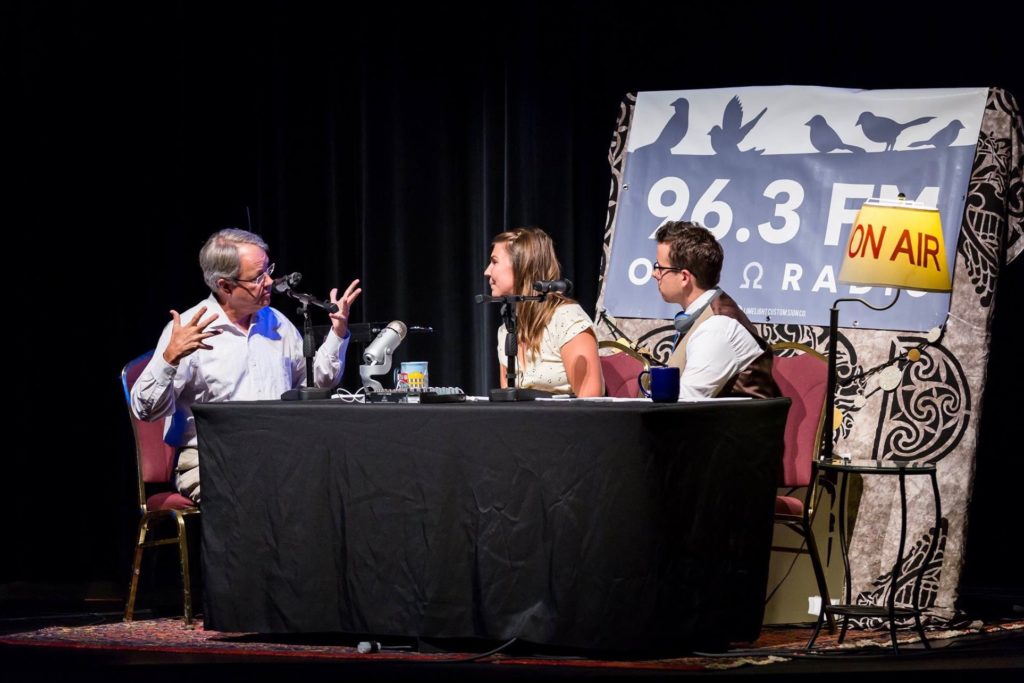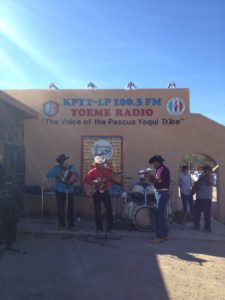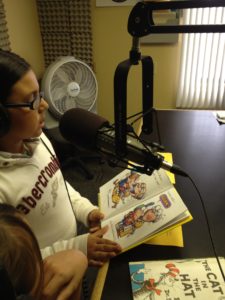Low-power FM radio shares community voices to a hyperlocal audience

On July 7, 2016, radio host Philip Gracia began a live Internet broadcast of WFNU in St. Paul, Minnesota, by saying, “We’re here to open up a discussion of what happened in St. Paul overnight. We’re here to discuss what we think, what we feel… Sometimes you don’t know exactly what you feel. You feel angry, you feel confused, you feel sad.”
The night before, just a few miles away in Falcon Heights, a police officer had fatally shot Philando Castile during a traffic stop, and Castile’s girlfriend had filmed the aftermath in a live Facebook video. Less than 24 hours later, the hosts from WFNU sat down for a free-flowing discussion, open to any local residents who wanted to call in or stop by the studio.
At the time, WFNU was just weeks away from being able to broadcast over the airwaves: On August 3, the station erected their crowd-funded antenna with the help of the media justice group Prometheus Radio Project. But they had been producing radio shows out of the Center for Hmong Arts and Talent in the Frogtown neighborhood of St. Paul since April 2015.
WFNU, also known as Frogtown Community Radio, is one of about 1,600 community stations that broadcast on a low-power FM frequency. By definition, the radio signal of a low-power FM station can reach only a small area, up to about a 5-mile radius. For these stations, though, having a limited geographic range is an asset. It allows them to focus closely on the people and issues of a neighborhood — including, as with the death of Philando Castile, those that hit especially close to home.
“In a lot of models of business, [the limited reach] would be a severe hindrance, but it also provides a tremendous opportunity,” says Brendan Kelly, station manager at KRSM, which is a partner of WFNU and will go on the air in Minneapolis later this year. “It means if you do a good job reaching out to the community that surrounds you, making them welcome inside your station, putting them in positions of power and decision-making, you can really make it a tool for all of the communities that live in that area.”

Another benefit of low-power FM is that radio is an accessible medium for both producers and listeners. It doesn’t require literacy or extensive technical training, and a single platform can support many languages and types of programming. And radio has the potential to reach a large and diverse audience, because most Americans still listen to it: According to a 2015 Pew Research study, 91% of those aged 12 and older had heard a terrestrial radio broadcast within the previous week. Meanwhile, online radio listenership has doubled since 2010.
WFNU is one of several stations with low-power permits that are sharing audio content on the Internet — either in conjunction with traditional radio broadcasting or while working towards being able to broadcast via an FM signal. The growth of podcasting and online live streaming has helped these community stations experiment and reach new audiences, but that doesn’t mean the terrestrial signal is obsolete.
“The Internet is really good at a lot of things, but it’s not all that good at localism,” explains Will Floyd, technical director at the Prometheus Radio Project.
“Even with all of the benefits of being able to communicate widely, low-power FM and community radio stations in general are more about bringing the local community together,” Floyd says. “They’re civic institutions that provide a different kind of service than you can provide remotely over the Internet.”
Low-power FM radio is community-rooted by nature: The service was designated by the Federal Communications Commission (FCC) as a hyperlocal option for radio.
Community radio became an urgent cause in the late 1990s, after the Telecommunications Act of 1996 consolidated media ownership by removing restrictions on the number of broadcast stations that could be owned by a single company. Most radio stations came under the ownership of one of a few corporations, including Clear Channel (now iHeartMedia) and Cumulus. In many cases, generic programming replaced original shows specific to each market.
It was in the wake of the 1996 act that the Prometheus Radio Project formed. The organization grew out of a network of pirate broadcasters, led by Philadelphia’s Radio Mutiny, who lobbied for a legal alternative to pirate radio. Because of their advocacy, the FCC introduced the low-power FM service in 2000 and allowed organizations to apply for broadcasting permits.
Low-power FM quickly faced a setback, however: Existing broadcasters claimed that community stations would interfere with their radio frequencies and threaten their listenership. The Radio Broadcasting Preservation Act of 2000 limited licenses for low-power stations, restricting their ability to overlap with established broadcast areas. That meant that low-power FM was excluded from major media markets.
Prometheus and other community radio advocates fought back, mounting a campaign to repeal the law, and over the next decade several versions of the Local Community Radio Act were introduced in Congress. Finally, the bill was signed into law in 2011. For a two-week window in 2013, noncommercial organizations could apply to the FCC for a low-power FM permit.
After the success of their campaign to expand low-power radio, Prometheus kicked into gear to encourage nonprofits and other community groups to apply for those permits. The FCC application is the kind of complex task for which professional organizations hire attorneys and engineers, Will Floyd says. To make it accessible, Prometheus built open-source software for engineering and arranged to work with attorneys pro bono. After processing the applications, the FCC issued about 2,800 permits.
Then began the process of getting those stations ready to broadcast — another aspect of Prometheus’ work. As technical director, Floyd visits stations around the country to help them set up antennas, install studio equipment, train volunteers, and more.
A big part of getting a station ready to broadcast is simply making the community aware of it and inviting people to contribute, Floyd says. One way Prometheus encourages that is by helping stations host “barn-raisings,” in which a single community event builds the station from the ground up. Local residents can get involved by installing furniture, soldering cables, recording station IDs, or otherwise lending a hand. Such events get community members excited and allow them to participate — and since most of these stations are designed to be run largely by volunteers, attracting that hands-on support is crucial.
The most recent permits granted by the FCC require the stations to start broadcasting within three years. Several hundred stations have gone live since obtaining their permits, but around 1,000 stations are still in the process, Floyd says.
Other low-power FM stations have now been broadcasting for a decade or more, having received their licenses after the original introduction of low-power FM in 2000. Because of the law that prevented low-power stations in major markets, some of the longer-running stations are those that serve communities in more remote areas. Farm workers’ rights groups use low-power FM radio to share ongoing news and issues with the workers who live within broadcast range, including the Coalition of Immokalee Workers in Florida and the Oregon-based Pineros y Campesinos Unidos del Noroeste (PCUN).
For PCUN, their station KPCN: Radio Movimiento is a valuable way to translate national and international news not only into Spanish and indigenous languages, but also to discuss its relevance to the local workers and community members. “We put it in words people understand,” says Fabiola Ramos, KPCN’s programming director.
In addition to using collective bargaining to advocate for farm workers, PCUN advocates for immigrants and immigration reform. KPCN, whose slogan is “La Voz del Pueblo,” or “The Voice of the People,” shares information on local and national issues around immigration, as well as music and other news. The low-power signal allows the station to share “voices never heard on commercial Spanish-language radio or by a mass audience,” their mission states — including youth, women, workers, and indigenous people.

Some Native nations have low-power FM stations as well, sharing tribal news along with music and other programming. The Pascua Yaqui tribe’s station in Arizona, KPYT, has been broadcasting via the low-power signal and online for 11 years. Shortly after going on the air in 2005, the station surveyed tribe members to learn what they wanted to hear; now, the mix of musical genres they play reflects that survey, including Tejano, Yaqui folk music, and classic rock. For general manager Hector Youtsey, who worked in commercial radio before helping launch KPYT, the freedom to decide what goes on the air instead of having playlists dictated is “a night and day difference.”
KPYT is a key source of daily local information, working with the tribal council to broadcast regular public service announcements. Youtsey remembers receiving a call that an area bridge was out due to a storm; he was able to rush into the studio, record a PSA, and have it on the air in 15 minutes.
Another low-power station, New Orleans’ WHIV, is dedicated to sharing stories and conversations around AIDS and HIV. Baton Rouge and New Orleans are regularly among the U.S. cities with the highest rates of new HIV infections. The station’s mission is to break down the stigma that has contributed to HIV’s spread — even just saying the letters “HIV” when identifying the station is designed to combat shameful silence about the disease. WHIV also has more general goals of including marginalized communities and highlighting independent New Orleans musicians.
Other stations have a more broad but explicit mission to create democratic, accessible media. Ohm Radio, based in Charleston, South Carolina, was launched by Media Reform SC, a nonprofit dedicated to promoting freedom of the press as a keystone of democracy. The name of the station comes from the fact that an ohm is a unit of resistance in physics. “We are resisting corporate, piped-in radio that is not relevant or connected to our community,” says Vikki Matsis, the station’s president. “We are resisting our news and information being influenced by money and advertising.”
After the short 2013 window, it’s unlikely that the FCC will ever release more permits for low-power FM stations. For now, no alternative form of radio offers quite the same accessibility for both producers and listeners — with online radio, for example, the bandwidth to transmit a livestream can get expensive and is not as widely available as terrestrial radio. But Internet streaming radio continues to grow, and Prometheus offers resources and advice on creating podcasts as well.
Many of the lessons of low-power are valuable for these other audio outlets, and for any community media initiative. When setting up an alternative to traditional media, communities can be creative, experimenting with content and format. “Your community has a powerful new tool, and there are a million ways to use it,” advises Prometheus’ low-power FM guidebook. “Consider experimental spoken-word broadcasts like radio dramas or storytelling hours. What about an on-air swap meet, or a health call-in show hosted by a local doctor? A farm report for local farmers? How about a youth poetry show?”
Community media outlets can also be stronger and grow their audiences when they band together — as with WFNU, KRSM, and their partner WEQY, whose broadcast areas overlap in Minneapolis-St. Paul and who plan to produce some shared programming as they each get off the ground.
Most importantly, it’s essential for these ventures to include and work to represent the community. Each station manager emphasizes that while it might be hard to find committed volunteers to produce shows consistently, it’s essential to involve the community and invite the public into programming and other decisions.
“We play music and things we don’t necessarily like on our station, but that isn’t the point,” Vikki Matsis says. “The point is to present information to the public and let them decide. Being exposed to different viewpoints and cultures helps us to grow, and that is a beautiful thing.”
“There’s an easy temptation to sort of plant the flag and decide what the community needs,” says KRSM’s Brendan Kelly, “but it’s important to remember that community has lots of faces and lots of narratives, lots of different opinions and lots of different perspectives about the same things. … Without community, it’s not community media.”
More stations will go on the air later this year as permit holders continue to put up antennas, assemble studio equipment, and recruit on-air hosts and producers. Visit Prometheus Radio Project to learn more about low-power FM and to find out where you can listen in your community.
